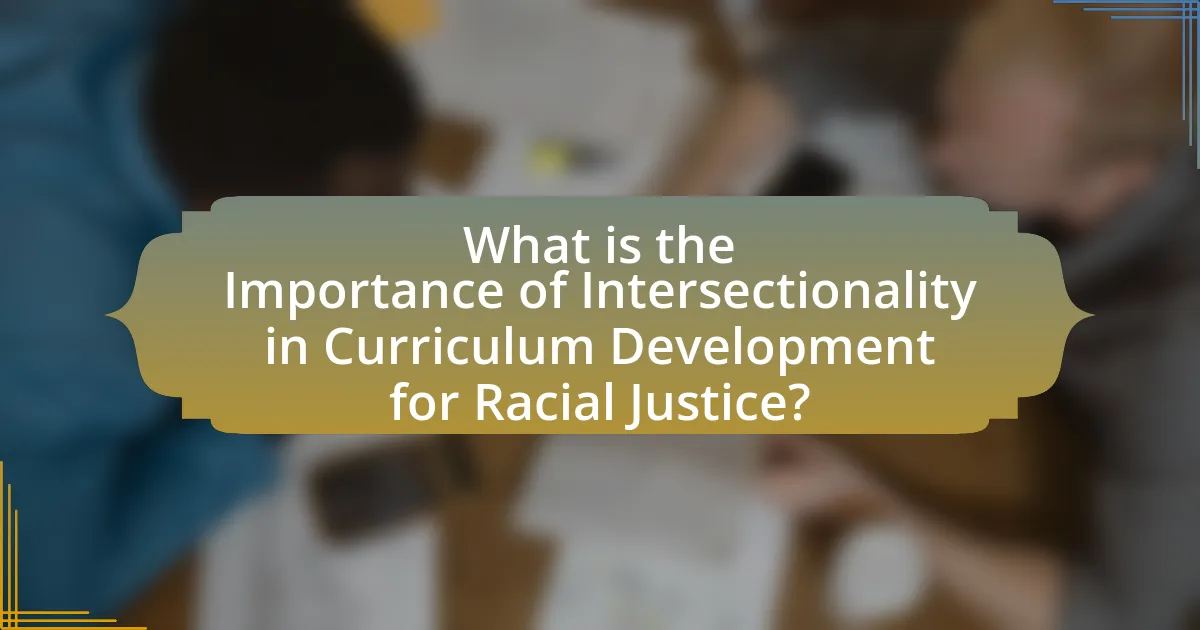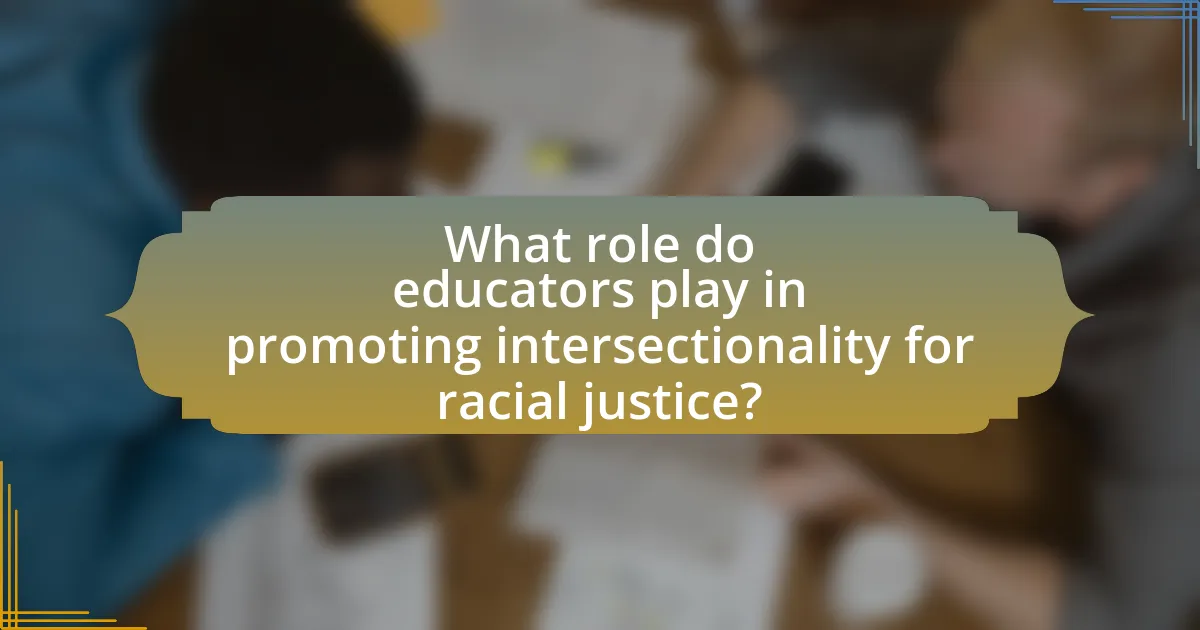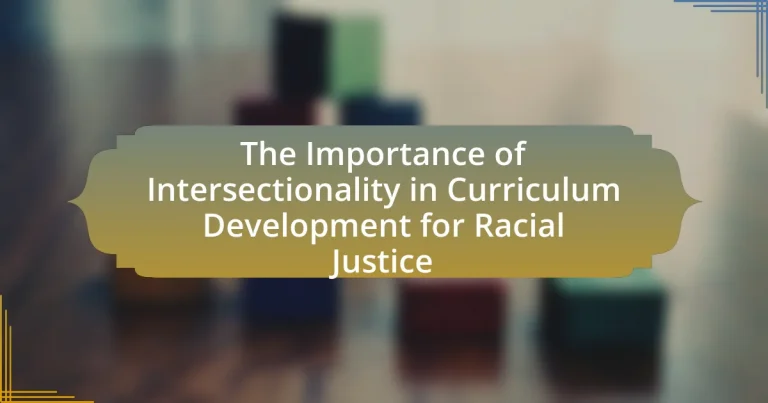The article focuses on the significance of intersectionality in curriculum development for racial justice, emphasizing how this framework enhances educational equity by reflecting the diverse identities and experiences of students. It discusses the complexities of how race interacts with other social categories, such as gender and class, and highlights the benefits of integrating intersectional perspectives into curricula, including improved critical thinking and empathy among students. The article also addresses the challenges educators face in implementing intersectionality, the role of policymakers, and best practices for fostering inclusive educational environments that promote social justice.

What is the Importance of Intersectionality in Curriculum Development for Racial Justice?
Intersectionality is crucial in curriculum development for racial justice as it ensures that educational content reflects the diverse experiences and identities of all students. By incorporating intersectional perspectives, educators can address the complexities of how race interacts with other social categories such as gender, class, and sexuality, leading to a more inclusive and equitable learning environment. Research indicates that curricula that embrace intersectionality can enhance critical thinking and empathy among students, fostering a deeper understanding of systemic inequalities. For instance, the work of Kimberlé Crenshaw, who coined the term “intersectionality,” highlights how overlapping identities can compound discrimination, underscoring the need for educational frameworks that recognize and address these multifaceted issues.
Why is intersectionality a critical framework in education?
Intersectionality is a critical framework in education because it allows for a comprehensive understanding of how various social identities—such as race, gender, class, and sexuality—interact to shape individual experiences and systemic inequalities. This framework is essential for developing curricula that address the complexities of students’ lives and promote racial justice. Research by Crenshaw (1989) highlights that traditional approaches often overlook the unique challenges faced by individuals at the intersections of multiple identities, leading to ineffective educational practices. By incorporating intersectionality, educators can create more inclusive and equitable learning environments that recognize and respond to the diverse needs of all students.
What are the key principles of intersectionality?
The key principles of intersectionality include the recognition that individuals experience multiple, overlapping identities that shape their social experiences and access to power. This framework emphasizes that social categories such as race, gender, class, sexuality, and ability do not exist independently but interact to create unique systems of oppression and privilege. For instance, a Black woman may face discrimination that is different from that experienced by a white woman or a Black man, highlighting the necessity of considering these intersecting identities in discussions of social justice. Intersectionality was first coined by Kimberlé Crenshaw in 1989, illustrating how legal and social systems often fail to address the complexities of individuals’ lived experiences.
How does intersectionality relate to racial justice?
Intersectionality is crucial to racial justice as it recognizes that individuals experience multiple, overlapping identities that affect their social experiences and access to resources. This framework highlights how race intersects with other factors such as gender, class, and sexuality, leading to unique forms of discrimination and privilege. For instance, Black women face both racial and gender discrimination, which can compound their experiences of injustice compared to their white counterparts. Research by Kimberlé Crenshaw, who coined the term “intersectionality,” illustrates that understanding these intersections is essential for addressing systemic inequalities effectively. By applying an intersectional lens, racial justice initiatives can better target the specific needs of diverse communities, ensuring that all voices are heard and considered in the fight for equity.
How does intersectionality influence curriculum design?
Intersectionality influences curriculum design by ensuring that educational content reflects the diverse identities and experiences of students, thereby promoting inclusivity and equity. This approach recognizes that individuals experience overlapping social identities, such as race, gender, and socioeconomic status, which shape their educational experiences and needs. For instance, a curriculum that incorporates intersectional perspectives can address systemic inequalities and provide a more comprehensive understanding of social justice issues. Research by Crenshaw (1989) highlights how intersectionality can reveal the complexities of discrimination, suggesting that curricula designed with this framework can better prepare students to engage with and challenge societal injustices.
What are the benefits of integrating intersectionality into curricula?
Integrating intersectionality into curricula enhances educational equity and fosters a deeper understanding of social justice issues. This approach allows students to recognize how various social identities—such as race, gender, class, and sexuality—interact and contribute to unique experiences of privilege and oppression. Research indicates that curricula incorporating intersectional perspectives can improve critical thinking skills and promote empathy among students, as they learn to appreciate diverse viewpoints and experiences. For instance, a study by Crenshaw (1989) highlights how intersectionality reveals the complexities of discrimination faced by individuals at the intersections of multiple identities, thereby enriching discussions around racial justice and social equity.
How can educators apply intersectional approaches in lesson planning?
Educators can apply intersectional approaches in lesson planning by integrating diverse perspectives and experiences that reflect the complexities of students’ identities. This involves designing curricula that consider factors such as race, gender, socioeconomic status, and ability, ensuring that all voices are represented and valued. For instance, incorporating literature from authors of various backgrounds can provide students with a broader understanding of societal issues and promote empathy. Research indicates that inclusive curricula enhance student engagement and academic performance, as seen in studies like “The Impact of Culturally Relevant Pedagogy on Student Achievement” by Ladson-Billings, which highlights the positive effects of culturally responsive teaching on marginalized students.
What challenges arise when implementing intersectionality in curriculum development?
Implementing intersectionality in curriculum development presents challenges such as resistance from stakeholders, lack of resources, and insufficient training for educators. Resistance often stems from differing beliefs about the importance of intersectionality, which can hinder collaborative efforts to create inclusive curricula. Additionally, limited financial and material resources can restrict the ability to develop comprehensive materials that reflect diverse perspectives. Furthermore, educators may lack the necessary training to effectively integrate intersectional approaches, leading to superficial implementation rather than meaningful engagement with the complexities of identity and social justice. These challenges highlight the need for systemic support and ongoing professional development to foster an inclusive educational environment.
What resistance might educators face in adopting intersectional frameworks?
Educators may face resistance in adopting intersectional frameworks due to entrenched beliefs and systemic biases within educational institutions. This resistance often stems from a lack of understanding of intersectionality, leading to misconceptions that it complicates curriculum development rather than enriching it. Additionally, educators may encounter pushback from stakeholders who fear that intersectional approaches challenge traditional narratives or threaten established power dynamics. Research indicates that institutional inertia and a lack of professional development opportunities further hinder the integration of intersectional frameworks, as educators may feel ill-equipped to implement these concepts effectively.
How can these challenges be addressed effectively?
To address the challenges of integrating intersectionality in curriculum development for racial justice effectively, educational institutions must implement comprehensive training programs for educators. These programs should focus on understanding the complexities of race, gender, class, and other intersecting identities, enabling teachers to create inclusive and equitable learning environments. Research indicates that professional development in culturally responsive teaching significantly enhances educators’ ability to address diverse student needs, as evidenced by a study from the National Education Association, which found that 80% of teachers reported improved classroom dynamics after such training. Additionally, incorporating diverse perspectives and voices in the curriculum itself can foster a more inclusive educational experience, as highlighted by the work of scholars like Kimberlé Crenshaw, who emphasizes the necessity of recognizing multiple identities in discussions of social justice.
How does intersectionality enhance student engagement and learning outcomes?
Intersectionality enhances student engagement and learning outcomes by recognizing and addressing the diverse identities and experiences of students, which fosters a more inclusive learning environment. This approach allows educators to tailor their teaching methods and materials to reflect the varied backgrounds of students, thereby increasing relevance and relatability. Research indicates that when students see their identities represented in the curriculum, they are more likely to participate actively and perform better academically. For instance, a study published in the “Journal of Educational Psychology” found that students who engaged with culturally relevant pedagogy demonstrated higher levels of motivation and achievement. By integrating intersectionality into curriculum development, educators can create a more equitable educational experience that supports all students’ success.
What evidence supports the effectiveness of intersectional curricula?
Evidence supporting the effectiveness of intersectional curricula includes improved student engagement and academic performance, as demonstrated in studies such as “The Impact of Intersectionality on Student Learning” by Crenshaw and others, published in the Journal of Educational Research. This research indicates that curricula incorporating diverse perspectives lead to higher levels of critical thinking and empathy among students. Additionally, a meta-analysis conducted by the American Educational Research Association found that intersectional approaches in education significantly reduce racial and gender biases, fostering a more inclusive learning environment. These findings collectively affirm that intersectional curricula enhance educational outcomes and promote social justice.
How do diverse perspectives contribute to a richer learning environment?
Diverse perspectives contribute to a richer learning environment by fostering critical thinking and enhancing creativity. When students engage with a variety of viewpoints, they are exposed to different problem-solving approaches and cultural insights, which broadens their understanding of complex issues. Research indicates that classrooms with diverse perspectives lead to improved academic performance and greater student engagement, as evidenced by a study published in the Journal of Educational Psychology, which found that diverse groups outperform homogeneous ones in collaborative tasks. This diversity not only enriches discussions but also prepares students for a globalized workforce, where collaboration across cultures is essential.

What role do educators play in promoting intersectionality for racial justice?
Educators play a crucial role in promoting intersectionality for racial justice by integrating diverse perspectives and experiences into the curriculum. This approach helps students understand how various social identities, such as race, gender, and class, intersect and contribute to systemic inequalities. Research indicates that inclusive curricula can enhance critical thinking and empathy among students, fostering a more equitable learning environment. For instance, studies show that when students engage with materials that reflect multiple identities, they are more likely to challenge stereotypes and advocate for social justice. Thus, educators are instrumental in shaping a curriculum that not only addresses racial issues but also highlights the interconnectedness of various forms of oppression.
How can teachers advocate for intersectional practices in their schools?
Teachers can advocate for intersectional practices in their schools by implementing inclusive curricula that reflect diverse perspectives and experiences. This involves integrating materials that address the intersections of race, gender, sexuality, and socioeconomic status, ensuring that all students see themselves represented in their education. Research shows that inclusive curricula can improve student engagement and academic performance, as evidenced by a study published in the Journal of Educational Psychology, which found that students exposed to diverse perspectives demonstrated higher levels of critical thinking and empathy. Additionally, teachers can collaborate with community organizations to provide resources and training on intersectionality, fostering a school culture that values diversity and equity.
What strategies can educators use to foster inclusive discussions?
Educators can foster inclusive discussions by implementing strategies such as establishing ground rules, encouraging diverse perspectives, and utilizing collaborative learning techniques. Establishing ground rules creates a safe environment where all participants feel respected and valued, which is essential for open dialogue. Encouraging diverse perspectives allows students to share their unique experiences and viewpoints, enriching the discussion and promoting understanding of intersectionality. Collaborative learning techniques, such as group projects or peer discussions, facilitate interaction among students from different backgrounds, fostering a sense of community and shared learning. These strategies are supported by research indicating that inclusive classroom environments enhance student engagement and learning outcomes, particularly in discussions surrounding complex social issues like racial justice.
How can professional development support teachers in this area?
Professional development can support teachers in understanding and implementing intersectionality in curriculum development for racial justice by providing targeted training and resources. Such professional development equips educators with the knowledge to recognize and address the diverse identities and experiences of their students, fostering an inclusive learning environment. Research indicates that teachers who engage in professional development focused on culturally responsive pedagogy are better prepared to integrate intersectional perspectives into their teaching practices, leading to improved student engagement and academic outcomes. For instance, a study by Ladson-Billings (1994) highlights that teachers who understand the complexities of race, class, and gender can create more equitable learning experiences.
What resources are available for educators to learn about intersectionality?
Educators can access various resources to learn about intersectionality, including academic journals, online courses, and books. Notable academic journals such as “Signs: Journal of Women in Culture and Society” and “Journal of Intersectionality” publish peer-reviewed articles that explore intersectionality in depth. Online platforms like Coursera and edX offer courses specifically focused on intersectionality, often created by universities and experts in the field. Additionally, books such as “Intersectionality” by Kimberlé Crenshaw and “Mapping the Margins” provide foundational knowledge and critical insights into the concept. These resources collectively enhance educators’ understanding of intersectionality, which is essential for developing curricula that promote racial justice.
What types of training programs focus on intersectionality in education?
Training programs that focus on intersectionality in education include workshops, professional development courses, and certification programs specifically designed to address diverse identities and systemic inequalities. These programs often incorporate frameworks that analyze how race, gender, class, and other social categories intersect to impact educational experiences. For example, the “Teaching Tolerance” initiative offers resources and training aimed at fostering inclusive classrooms that recognize and address intersectional issues. Additionally, universities may provide graduate-level courses on critical pedagogy that emphasize intersectionality, equipping educators with the tools to create equitable learning environments.
How can educators access relevant literature and research?
Educators can access relevant literature and research through academic databases, educational journals, and online repositories. Platforms such as JSTOR, Google Scholar, and ERIC provide extensive collections of peer-reviewed articles and research studies focused on intersectionality and racial justice in curriculum development. For instance, a study titled “Intersectionality and Education: A Framework for Understanding Racial Justice” published in the Journal of Curriculum Studies highlights the significance of integrating intersectional perspectives in educational practices. Accessing these resources enables educators to stay informed about current research and best practices in the field.

What are the implications of intersectionality for future curriculum development?
Intersectionality implies that future curriculum development must integrate diverse perspectives and experiences to address systemic inequalities effectively. By recognizing how various social identities—such as race, gender, class, and sexuality—interact, educators can create more inclusive and relevant educational content. Research by Crenshaw (1989) highlights that traditional curricula often overlook the complexities of marginalized identities, leading to a lack of representation and understanding in educational settings. Therefore, incorporating intersectional frameworks can enhance critical thinking and empathy among students, fostering a more equitable learning environment that prepares them to engage with a diverse society.
How can intersectionality shape educational policies and practices?
Intersectionality can shape educational policies and practices by ensuring that diverse identities and experiences are recognized and addressed in curriculum development. This approach promotes inclusivity and equity, allowing for the consideration of how overlapping social identities—such as race, gender, socioeconomic status, and ability—impact students’ educational experiences. Research by Crenshaw (1989) highlights that without an intersectional lens, policies may inadvertently perpetuate systemic inequalities, as they often fail to account for the unique challenges faced by marginalized groups. By integrating intersectionality into educational frameworks, policymakers can create more effective and responsive practices that foster racial justice and support all students’ learning needs.
What role do policymakers play in supporting intersectional education?
Policymakers play a crucial role in supporting intersectional education by creating and implementing policies that promote inclusive curricula and equitable educational practices. They can allocate funding for programs that address the diverse needs of students from various racial, gender, and socioeconomic backgrounds, ensuring that educational materials reflect multiple perspectives. For instance, the Every Student Succeeds Act (ESSA) emphasizes the importance of equity in education, allowing states to develop strategies that incorporate intersectional approaches. By establishing standards and guidelines that prioritize diversity and inclusion, policymakers help foster an educational environment that acknowledges and addresses systemic inequalities, ultimately contributing to racial justice in curriculum development.
How can community involvement enhance intersectional curriculum initiatives?
Community involvement enhances intersectional curriculum initiatives by integrating diverse perspectives and experiences that reflect the complexities of social identities. Engaging community members, particularly those from marginalized groups, allows educators to develop curricula that address specific cultural, historical, and social contexts relevant to those communities. For instance, research by the National Education Association indicates that inclusive curricula improve student engagement and academic performance, particularly among students of color. This collaboration fosters a more holistic understanding of intersectionality, ensuring that educational content is not only relevant but also empowering for all students.
What best practices should educators follow when developing intersectional curricula?
Educators should prioritize inclusivity and representation when developing intersectional curricula. This involves integrating diverse perspectives and experiences from various racial, gender, and socioeconomic backgrounds into the curriculum. Research indicates that curricula reflecting multiple identities enhance student engagement and learning outcomes, as seen in studies by the American Educational Research Association, which highlight the positive impact of culturally relevant pedagogy on student achievement. Additionally, educators should collaborate with community members and stakeholders to ensure that the curriculum addresses the needs and realities of all students, fostering a more equitable educational environment.
How can educators ensure that all voices are represented in the curriculum?
Educators can ensure that all voices are represented in the curriculum by actively incorporating diverse perspectives and materials that reflect the experiences of various racial, cultural, and social groups. This can be achieved through the selection of texts, resources, and case studies that highlight underrepresented voices, ensuring that the curriculum is inclusive and representative of the student population. Research indicates that inclusive curricula can enhance student engagement and academic performance, as seen in studies like “The Impact of Culturally Relevant Pedagogy on Student Achievement” by Ladson-Billings, which demonstrates that students perform better when they see their identities reflected in their learning materials.
What assessment methods can be used to evaluate intersectional learning?
Assessment methods that can be used to evaluate intersectional learning include reflective journals, peer assessments, and case studies. Reflective journals allow learners to articulate their experiences and insights related to intersectionality, fostering critical thinking and self-awareness. Peer assessments encourage collaboration and provide diverse perspectives, enhancing understanding of intersectional issues. Case studies present real-world scenarios that require learners to analyze and apply intersectional frameworks, demonstrating their grasp of complex social dynamics. These methods collectively support a comprehensive evaluation of intersectional learning by engaging learners in critical reflection, collaboration, and practical application.


